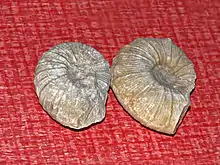| Holcodiscus | |
|---|---|
 | |
| Fossil shell of Holcodiscus fallax from Alpes-de-Haute-Provence, on display at Galerie de paléontologie et d'anatomie comparée in Paris | |
| Scientific classification | |
| Domain: | Eukaryota |
| Kingdom: | Animalia |
| Phylum: | Mollusca |
| Class: | Cephalopoda |
| Subclass: | †Ammonoidea |
| Order: | †Ammonitida |
| Family: | †Holcodiscidae |
| Genus: | †Holcodiscus Uhlig 1882 |
Holcodiscus is an extinct ammonite genus placed in the family Holcodiscidae. Species in this genus were fast-moving nektonic carnivores.[2] The type species of the genus is Ammonites caillaudianus.[2]
Description
Circular to rectangular whorl section; fine, low, straight or flexuous simple or branched ribs, periodically truncated by thin, high, enlarged ribs bearing lateral and ventrolateral tubercles; inner whorls tending to have depressed whorl section and to resemble Olcostephanus.[3]
Species [2]
- Holcodiscus caillaudianus d'Orbigny 1850
- Holcodiscus camelinus d'Orbigny 1850
- Holcodiscus hauthali Paulcke 1907
- Holcodiscus tenuistriatus Paulcke 1907
Distribution
Fossils of species within this genus have been found in the Cretaceous sediments of Austria, Bulgaria, Chile, Colombia, Czech Republic, Slovakia, France, Italy, Morocco, Spain and Russia.[2]
Gallery
_at_the_Sofia_University_'St._Kliment_Ohridski'_Museum_of_Paleontology_and_Historical_Geology.jpg.webp) Holcodiscus mediocostatus Tzankov, 1935, Barremian, Razgrad, Cr1 1716 (Coll. V. Tzankov) at the Sofia University Museum of Paleontology and Historical Geology
Holcodiscus mediocostatus Tzankov, 1935, Barremian, Razgrad, Cr1 1716 (Coll. V. Tzankov) at the Sofia University Museum of Paleontology and Historical Geology
Notes
- ↑ "Holcodiscus". Sepkoski's Online Genus Database – Cephalopoda.
- 1 2 3 4 5 "Holcodiscus". Paleobiology Database.
- ↑ Wright, C. W. with J.H. Callomon and M.K. Howarth (1996). Roger L. Kaesler (ed.). Mollusca 4 Revised, Cretaceous Ammonoidea, in Treatise on Invertebrate Paleontology, Part L. Vol. 4. Boulder, Colorado Lawrence, Kansas: The Geological Society of America & University of Kansas Press. p. 48. OCLC 61988855.
External links
- "Holcodiscus". mindat.org. Retrieved 30 December 2021.
- "Holcodiscus". Encyclopedia of Life (EOL). Retrieved 30 December 2021.
- Wright, Claud William; with John Hannes Callomon and M.K. Howarth (1996). Roger L. Kaesler (ed.). Mollusca 4 Revised, Cretaceous Ammonoidea in Treatise on Invertebrate Paleontology Part L. Boulder, Colorado and Lawrence, Kansas: The Geological Society of America & University of Kansas Press. p. 48.
{{cite book}}: CS1 maint: multiple names: authors list (link) - Arkell, W. J.; Furnish, W. M.; Kummel, Bernhard; Miller, A.K.; Moore, R.C.; Schindewolf, O.H. (1957). "Part L, Mollusca 4: Cephalopoda, Ammonoidea". In Raymond C. Moore (ed.). Treatise on Invertebrate Paleontology. Geological Society of America and University of Kansas Press. p. L371 – via Internet Archive.
This article is issued from Wikipedia. The text is licensed under Creative Commons - Attribution - Sharealike. Additional terms may apply for the media files.